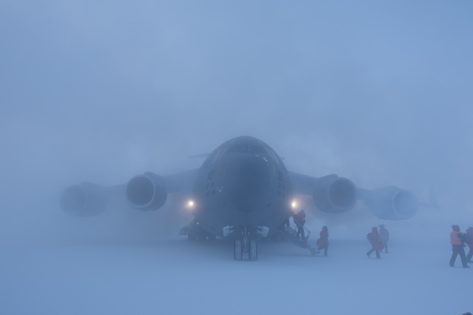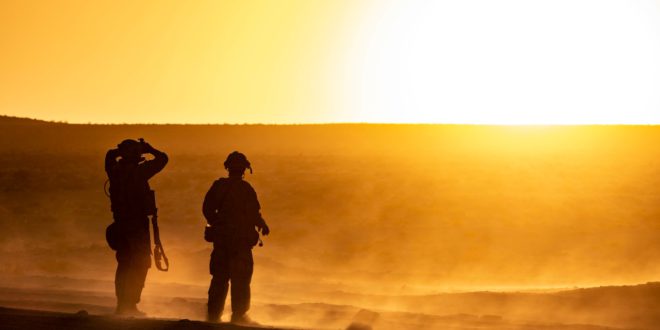The Defense Department is actively working with the whole-of-government to tackle the climate crisis, as underscored by two recently released documents that highlight the impact of climate change on national security.
The DOD Climate Risk Analysis identifies how global and cross-cutting consequences of climate change are likely to increase demands on the force. While the first DOD report focused on the strategic implications of climate change, DOD’s risk analysis provides a starting point for a shared understanding and lays out a path for integrating these considerations across strategic documents.
To ensure that DOD can meet these growing demands under changing climate conditions, the department also released its Climate Adaptation Plan. Building on more than a decade of work, the plan provides a roadmap to ensure DOD maintains the ability to operate under changing climate conditions while protecting systems essential to the country’s success.
With the DCRA and the CAP as the foundation, DOD is integrating climate change considerations across strategic guidance and planning documents, including the National Defense Strategy, which will be released in 2022. DOD is also working with allies and partners to prevent, mitigate, account for, and respond to defense and security risks associated with climate change.
At bilateral and multilateral meetings, defense officials regularly discuss climate change. For example, in Undersecretary of Defense for Policy Colin Kahl’s recent meeting with a top Brazilian official, the leaders acknowledged the importance of integrating climate change and its impacts into future defense dialogues. DOD also worked closely with NATO allies to develop a Climate Change and Security Agenda and Action Plan last summer.

SecDef:
Climate change is an existential threat to our nation’s security, and the Department of Defense must act swiftly and boldly to take on this challenge and prepare for damage that cannot be avoided. Every day, our forces contend with the grave and growing consequences of climate change, from hurricanes and wildfires that inflict costly harm on U.S. installations and constrain our ability to train and operate, to dangerous heat, drought, and floods that can trigger crises and instability around the world.
The Climate Adaptation Plan will be our guide for meeting the nation’s warfighting needs under increasingly extreme environmental conditions—and for maintaining force readiness and resilience well into the future.
This plan will help the Department of Defense integrate climate considerations into our operations, our planning, and our business and decision-making processes. That includes how we train and equip our forces and new measures to strengthen the resilience of our infrastructure. This plan will also help ensure that our supply chains adapt to the realities of our changing climate.
We must take on these challenges as a team—from every corner of the Pentagon, on each of our installations and bases, across the federal government, and alongside our partners and allies.
We do not intend merely to adapt to the devastation of climate change. We will work with nations around the world to meet the threat. Tackling these challenges also presents an opportunity, because the bold steps we are taking are good for the climate and also good for our mission of defending the nation. With this roadmap, the U.S. military will become even more resilient, efficient, and innovative—and remain the world’s preeminent fighting force, ready to confront the risks of today and tomorrow.
On Oct. 7, 2021, the White House released Climate Adaptation Plans from each agency, as required by Executive Order 14008, “Tackling the Climate Crisis At Home and Abroad.” The Department of Defense Climate Adaptation Plan, released with these plans, articulates a bold vision for climate adaptation and aligns adaptation and resilience efforts with the department’s warfighting mission. The DOD CAP is the culmination of more than 10 years of effort within the department to ensure that the military forces of the United States retain operational advantage under all conditions.
DOD’s Climate Adaptation Plan was approved by the Council on Environmental Quality and the Office of Management and Budget in June and signed by Secretary of Defense Lloyd J. Austin III on September 1, 2021. The DOD CAP lays out how operations, planning activities, business processes, and resource allocation decisions will include climate change considerations. No entity has the luxury of “opting out” of the effects of climate change, so no activity can “opt out” of the requirement to adapt to a changing climate.
DOD’s Strategy to Tackle the Climate Crisis
DOD’s efforts to “Ensure the Department of Defense can operate under changing climate conditions, preserving operational capability and enhancing the natural and man-made systems essential to the Department’s success” are outlined in the strategic framework graphic below.
To achieve the DOD’s strategic outcomes, the plan first centers the integration of climate-informed decision-making using actionable science into all department processes. All other actions in this plan are dependent on the outcomes of this effort.
Second, the DOD will train and equip a climate-ready force by focusing on operating under the most extreme and adverse conditions and integrating climate adaptation concepts into existing major exercises and contingency planning.
Third, the DOD will ensure built and natural infrastructure are in place for successful mission preparedness, military readiness and operational success in changing conditions and will leverage the Defense Climate Assessment Tool to develop comprehensive installation resilience plans.
Fourth, the DOD will insert climate change considerations into supply chain management to both reduce vulnerabilities and create opportunities to leverage the DOD’s purchasing power to advance the key technologies essential to a clean energy transformation.
And finally, the DOD will enhance adaptation and resilience through collaboration. The DOD recognizes the value of interagency and intergovernmental cooperation in meeting the challenges of climate change and reflects our commitment to working closely with other agencies in this room as well as our defense partners around the globe.
Four cross-cutting enablers will allow these efforts to succeed:1Continuous Monitoring and Data Analytics2Aligning Incentives to Reward Innovation3Climate Literacy or Human Capital4Environmental Justice
Climate change is a destabilizing force in the world, creating new missions and impacting the operational environment. Climate change can affect sources of raw materials, supplies, equipment, vehicles and weapons systems, as well as their distribution and storage. As DOD responds, it is critical that training, testing and acquisitions, not disproportionately impact low income and/or minority populations. The DOD’s environmental justice strategy includes environmental equity and justice in department organizational structures, policies and implementation guidance through inclusive and equitable climate adaptation and resilience as well as in agile mission assurance.
 Soldier of Fortune Magazine The Journal of Professional Adventurers
Soldier of Fortune Magazine The Journal of Professional Adventurers






